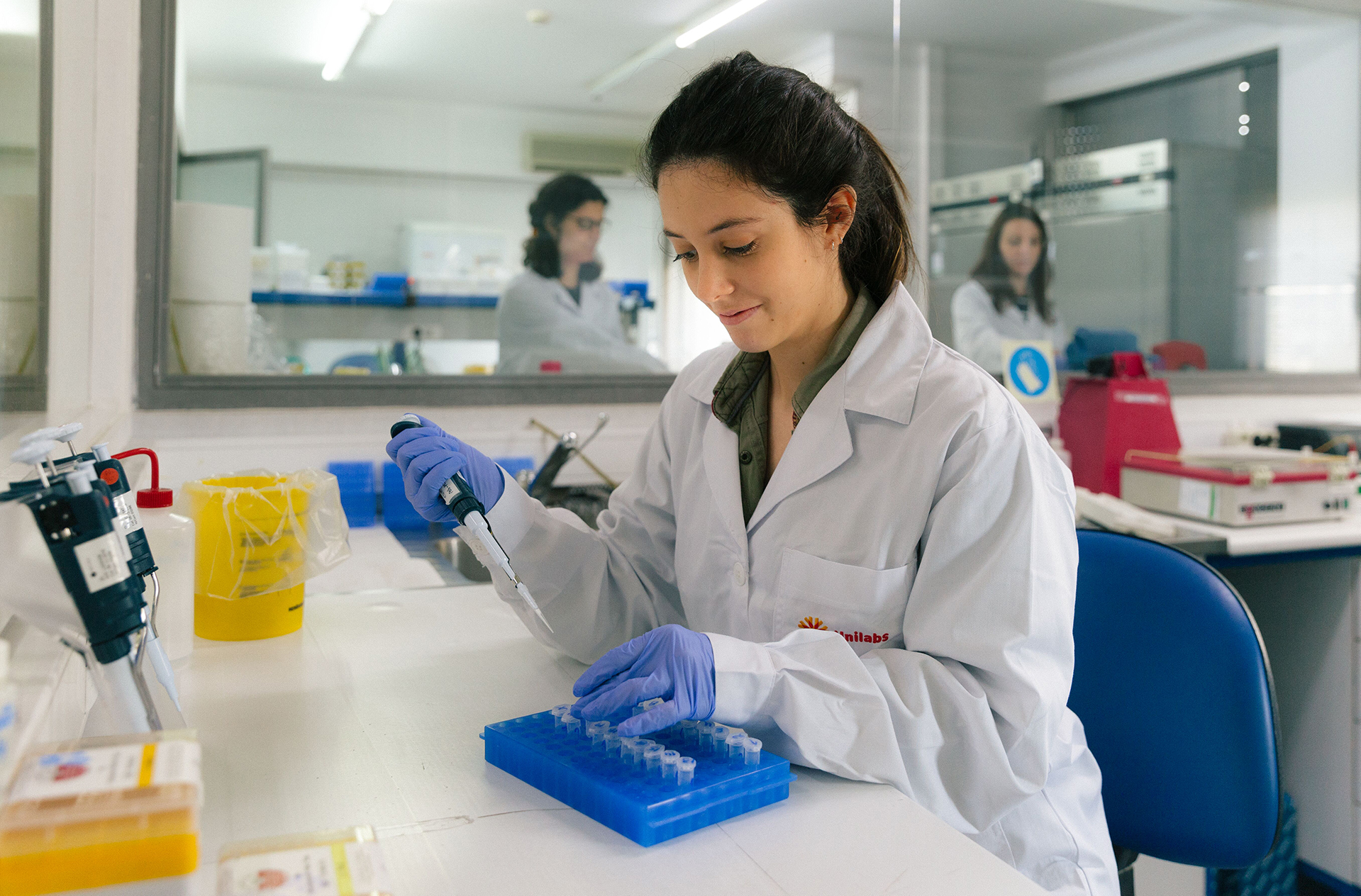Oncogenetics
Cancer is a wide collection of different pathologies characterized by an uncontrolled cellular growth and proliferation which is driven by genetic changes that are either acquired (somatic) and usually sequential (“driver” and “passenger” mutations), or inherited.
These key molecular aberrations can disrupt a complex network of intracellular pathways, internal checkpoints and safety nets eventually leading to malignancy.
Both the nature but also the highly heterogeneous profile of the molecular events leading to cancer are unique, not only for every patient but even among individual tumors. This fact alone, poses the new era challenge for modern oncology, and may hold the key to understanding, detecting, and treating a patient’s disease as there is no « one-size-fits-all » solution.
A correct diagnosis is the key to successful clinical management and the core element of personalized medicine through precision oncology. Molecular tumor diagnostics is a very powerful tool that enables the identification of highly precise biomarkers allowing an early neoplasia classification and prognosis, as well as identifying of the most appropriate therapy.
CORE CANCER PANELS
Cancer Specific Gene Panels
Our Core Cancer panels consist of essential gene sets that provide necessary information for genetic tumor biomarker profiling at the molecular level. These panels are usually dedicated for core tumor profiling and identification of therapeutically actionable variants.
Breast cancer is a serious pathology, affecting women across a large spectrum of ages. Due to its high heterogeneity, standard generic treatment approaches have been proven of limited efficacy and precision cancer medicine is needed to tailor clinical management. With the increasing implementation of NGS screening in clinical oncology, the number of actionable genomic alterations has expanded in recent years. Molecular testing of breast cancer is currently becoming the standard of care for guiding the use FDA and/or EMA approved targeted therapies such as PARP inhibitors and HER2-targeted immunotherapy. Mutations in the genes BRCA1, BRCA2 or PIK3CA have important implications in the cellular DNA repair mechanisms, and are associated with sensitivity and improved response to platinum-based chemotherapy and PAPR inhibitors. In addition, there is the possibility for extensive screening to help prognosis, tumor categorization and guidance for the use of FDA-approved drugs with an off-label indication.
This assay is designed to provide a thorough profile of the tumor and its behavior which is relevant for treatment response in standard of care but also emerging investigational clinical actions.
Who is this test for? Any patient diagnosed with breast cancer can have the molecular profile of their tumor, to help identify the key genetic alterations and biomarkers of clinical relevance for a personalized follow-up by their healthcare provider. This panel is highly recommended for patients with metastatic advanced breast cancer.
Sample type: FFPE Block or ≥10 sections of ≥5μm thickness with control slide or fresh tumor tissue
| TAT: 10 business days | Sensitivity: ≥ 98% | Specificity: 99 % | Mean Coverage: >500 x |
GENES TESTED:
| DNA based analysis (SNVs, CNVs) | AKT1, ATM, BARD1, BRAF, BRCA1, BRCA2, BRIP1, CHEK2, CTNNB1, DICER1, EGFR, ERBB2, ERBB3, ESR1, FBXW7, FOXA1, FOXL2, GATA3, KIT, KRAS, MAP3K1, MLH1, MRE11A, MSH2, MSH6 MTOR, NBN, NRAS, PALB2, PIK3CA, PIK3CB, PMS2, POLE, PTEN, RAD51C, RAD51D, RAF1, RET, RUNX1, SMAD4, TP53 |
| RNA based analysis (gene fusions) | ALK, AR, BCL2, BRAF, BRCA1, BRCA2, CDK4, CSF1R, EGFR, EML4, ERBB2, ERG, ESR1, ETS1, ETV1, ETV4, ETV5, EWSR1, FGFR1, FGFR2, FGFR3, FLI1, KIF5B, KIT, KMT2A, MET, MLLT3, MSH2, MYC, NRG1, NTRK1, NTRK2, NTRK3, PDGFRA, PDGFRB, PIK3CA, PPARG, RAF1, RET, ROS1, |
| MSI analysis | Assessment of 26 independent loci |
Ovarian cancer is the leading cause of death from gynecological cancers and standard generic treatment approaches have been proven of limited efficacy. With the increasing implementation of NGS screening in clinical oncology, the number of actionable genomic alterations has expanded in recent years. Molecular testing of ovarian cancer is currently becoming the standard of care for guiding the use FDA and/or EMA approved targeted therapies such as PARP inhibitors. Mutations in the genes BRCA1 and BRCA2 have important implications in the cellular DNA repair mechanisms, and were associated with sensitivity and improved response to platinum-based chemotherapy and PAPR inhibitors. In addition, there is the possibility for extensive screening to help prognosis, tumor categorization and guidance for the use of FDA-approved drugs with an off-label indication.
This assay is designed to provide a thorough profile of the tumor and its behavior, which is relevant for treatment response in standard of care but also in emerging investigational clinical actions.
Who is this test for? Any patient diagnosed with ovarian cancer can have the molecular profile of their tumor, to help identify the key genetic alterations and biomarkers of clinical relevance for a personalized follow-up by their healthcare provider.
Sample type: FFPE Block or ≥10 sections of ≥5μm thickness with control slide or fresh tumor tissue
| TAT: 10 business days | Sensitivity: ≥ 98% | Specificity: 99 % | Mean Coverage: >500 x |
GENES TESTED:
| DNA based analysis (SNVs, CNVs) | AKT1, ATM, BARD1, BRAF, BRCA1, BRCA2, BRIP1, CHEK2, CTNNB1, DICER1, EGFR, ERBB2, ERBB3, ESR1, FBXW7, FOXA1, FOXL2, GATA3, KIT, KRAS, MAP3K1, MLH1, MRE11A, MSH2, MSH6 MTOR, NBN, NRAS, PALB2, PIK3CA, PIK3CB, PMS2, POLE, PTEN, RAD51C, RAD51D, RAF1, RET, RUNX1, SMAD4, TP53 |
| RNA based analysis (gene fusions) | ALK, AR, BCL2, BRAF, BRCA1, BRCA2, CDK4, CSF1R, EGFR, EML4, ERBB2, ERG, ESR1, ETS1, ETV1, ETV4, ETV5, EWSR1, FGFR1, FGFR2, FGFR3, FLI1, KIF5B, KIT, KMT2A, MET, MLLT3, MSH2, MYC, NRG1, NTRK1, NTRK2, NTRK3, PDGFRA, PDGFRB, PIK3CA, PPARG, RAF1, RET, ROS1 |
| MSI analysis | Assessment of 26 independent loci |
Lung cancer is among the leading causes of cancer-related death worldwide, and patients typically respond poorly to traditional chemotherapy. More than 80% of lung cancer cases are classified as non-small cell lung cancer (NSCLC). With the implementation of NGS screening in clinical oncology, the number of actionable genomic alterations has expanded and individuals with advanced disease should undergo molecular screening to identify genetic abnormalities that may predict response to targeted therapies. In fact, molecular testing of NSCLC is currently becoming the standard of care for guiding the use of FDA and/or EMA approved targeted therapies such as inhibitors of EGFR, ALK and ROS1. In addition, there is growing clinical evidence supporting the efficacy of additional treatments such as BRAF, MEK and various tyrosine kinase inhibitors for NSCC patients defined upon the presence of specific genomic biomarkers.
The assay is designed to equip the healthcare providers with all the prognostic and clinically actionable information required for personalized therapeutics based on the specific tumor biology.
Who is this test for? Any patient diagnosed with lung cancer can have the molecular profile of their tumor, to help identify the key genetic alterations and biomarkers of clinical relevance for a personalized follow-up by their healthcare provider.
Sample type: FFPE Block or ≥10 sections of ≥5μm thickness with control slide or fresh tumor tissue
| TAT: 10 business days | Sensitivity: ≥ 98% | Specificity: 99 % | Mean Coverage: >500 x |
GENES TESTED:
| DNA based analysis (SNVs, CNVs) | AKT1, ALK, APC, ARAF, ATM, BRAF, BRCA1, BRCA2, CTNNB1, DDR2, EGFR, ERBB2, ERBB3, ERBB4, FBXW7, JAK2, KEAP1, KRAS, MAP2K1, MET, NRAS, NOTCH1, PDGFRA, PIK3CA, POLE, PTEN, RAF1, RET, ROS1, SMAD4, STK11, TP53 |
| RNA based analysis (gene fusions) | ALK, BRAF, BRCA1, BRCA2, CDK4, CSF1R, EGFR, EML4, ERBB2, ERG, ESR1, ETS1, ETV1, ETV4, FGFR1, FGFR2, FGFR3, FGFR4, KIT, KMT2A, MET, MLLT3, MSH2, MYC, NOTCH1, NOTCH2, NOTCH3, NTRK1, NTRK2, NTRK3, PAX3, PAX7, PDGFRA, PDGFRB, PIK3CA, RAF1, RET, ROS1, |
| MSI analysis | Assessment of 26 independent loci |
| 3 HOTSPOT GENES | EGFR, KRAS, NRAS (individual testing possible) |
Prostate cancer is the second most frequent neoplasia identified in men worldwide with a severe impact on patients’ quality of life. While patients with local and regional disease are treated with curative intent, a significant portion of patients suffers from disease that is more aggressive with high mortality rates. With the increasing implementation of NGS screening in clinical oncology, the number of actionable genomic alterations has expanded in recent years. Molecular testing of prostate cancer is currently becoming the standard of care for guiding the use FDA and/or EMA approved targeted therapies such as PARP and TRK inhibitors. While prostate cancer is highly heterogeneous on a molecular level, approximately, 50%-60% of metastatic cases harbor either mutations in the DNA-damage repair pathway (e.g. BRCA1, BRCA2) or present typical gene fusions (e.g. NTRK, TMPRSS2-ERG) that may serve as biomarkers both for prognosis but also for therapeutic management highlighting patients that may benefit from novel therapies.
This assay is designed to provide a thorough profile of the tumor and its behavior, which is relevant for treatment response in standard of care but also in emerging investigational clinical actions.
Who is this test for? Any patient diagnosed with prostate cancer can have the molecular profile of their tumor, to help identify the key genetic alterations and biomarkers of clinical relevance for a personalized follow-up by their healthcare provider. This test is highly recommended for patients with metastatic castration resistant prostate cancer.
Sample type: FFPE Block or ≥10 sections of ≥5μm thickness with control slide or fresh tumor tissue
| TAT: 10 business days | Sensitivity: ≥ 98% | Specificity: 99 % | Mean Coverage: >500 x |
GENES TESTED:
| DNA based analysis (SNVs, CNVs) | ABL1, APC, AKT1, AKT2, AKT3, ALK, AR, ARID1A, ATM, ATR, AURKA, AXL, BARD1, BAP1, BRAF, BRCA1, BRCA2, BRIP1, CCND1, CDKN1A, CDKN2A, CDK4, CDK6, CDK12, CDH1, CHEK1, CHEK2, CTNNB1, CTNNA1, DDR2, EGFR, EP300, ERBB2, ERBB3, ERBB4, ERCC2, ERG, ESR1, ETV1, ETV4, ETV5, FAM175A, FANCA, FANCL, FGFR1, FGFR2, FGFR3, FGFR4, FLT3, FOXA1, FBXW7, GNA11, GNAQ, GNAS, HRAS, IDH1, IDH2, JAK1, JAK2, JAK3, KRAS, KDM6A, KMT2C, KMT2D, KIT, NRAS, MAP2K1, MAP2K2, MED12, MET, MLH1, MRE11A, MSH2, MSH3, MSH6, MTOR, MUTYH, MYC, MYCN, NBN, NCOR1, NF1, NRAS, NTRK1, NTRK2, NTRK3, PALB2, PARP1, PDGFRA, PIK3CA, PIK3CB, PIK3R1, PIK3C2G, PMS1, PMS2, POLD1, POLE, PPARG, PTEN, RAF1, RAD51, RAD51B, RAD51C, RAD51D, RB1, RET, ROS1, RNF43, SMAD2, SPOP, TP53, VHL, ZFHX3, |
| RNA based analysis (gene fusions) | ABL1, ALK, AR, BCL2, BRAF, BRCA1, BRCA2, CDK4, CSF1R, EGFR, EML4, ERBB2, ERG, ESR1, ETS1, ETV1, ETV4, ETV5, EWSR1, FGFR1, FGFR2, FGFR3, FLI1, KIF5B, KIT, KMT2A, MET, MLLT3, MSH2, MYC, NRG1, NTRK1, NTRK2, NTRK3, PDGFRA, PDGFRB, PIK3CA, PPARG, RAF1, RET, ROS1, TMPRSS2 |
| MSI analysis | Assessment of 26 independent loci |
Melanoma
Cutaneous melanoma is the most dangerous form of skin cancer responsible for almost 80% of skin cancer mortality. Molecular characterization of the melanoma subtypes related to different mutational landscapes and testing for actionable genomic variants is becoming the standard of care. Our screening panel is specifically adapted to identify genetic alterations that are very frequent in melanoma and can currently guide the use of FDA and EMA approved targeted therapies such as BRAF, MEK and KIT inhibitors. In addition, there is the possibility for further investigational screening to help prognosis and tumor categorization, guiding for the use FDA-approved drugs with an off-label indication. .
This assay is designed to provide a thorough profile of the tumor and its behavior which is relevant for treatment response in standard of care but also emerging investigational clinical actions.
Who is this test for? Any patient diagnosed with melanoma can have tumour molecular profile with this panel to help identify the key genetic alterations and relevant biomarkers that are clinically relevant with their tumor.
Sample type: FFPE Block or ≥10 sections of ≥5μm thickness with control slide or fresh tumor tissue
| TAT: 10 business days | Sensitivity: ≥ 98% | Specificity: 99 % | Mean Coverage: >500 x |
GENES TESTED:
| DNA based analysis (SNVs, CNVs) | AKT1, ERBB3, ERBB4, ERG, ESR1, ETV1, ETV4, ETV5, FGFR1, FGFR2, FGFR3, FGFR4, (HER2), ERBB2, ALK, AR, AXL, BRAF, CCND1, CDK4, CDK6, CTNNB1, DDR2, EGFR, GNA11, GNAQ, MYCN, NRAS, NTRK1, NTRK2, NTRK3, PDGFRA, PIK3CA, PPARG, RAF1, RET, ROS1, MYC, MTOR, HRAS, IDH1, IDH2, JAK1, JAK2, JAK3, KIT, KRAS, MAP2K1, MAP2K2, MET, SMO |
| RNA based analysis (gene fusions) | ABL1, AKT3, ALK, AR, AXL, BCL2, BRAF, BRCA1, BRCA2, CDK4, CSF1R, EGFR, EML4, ERBB2, ERG, ESR1, ETS1, ETV1, ETV4, ETV5, EWSR1, FGFR1, FGFR2, FGFR3, FGFR4, FLI1, FLT1, FLT3, JAK2, KDR, KIF5B, KIT, KMT2A, MET, MLLT3, MSH2, MYC, NOTCH1, NOTCH2, NOTCH3, NRG1, NTRK1, NTRK2, NTRK3, PAX3, PAX7, PDGFRA, PDGFRB, PIK3CA, PPARG, RAF1, RET, ROS1, RPS6KB1, TMPRSS2, TP53 |
| MSI analysis | Assessment of 26 independent loci |
| 3 "HOTSPOT" genes | EGFR, KRAS, NRAS (individual testing possible) |
Colorectal cancer (CRC) is among the leading causes of cancer-related mortality worldwide. With the increasing implementation of NGS screening in clinical oncology, the number of actionable genomic alterations has expanded in recent years. Molecular testing of CRC is currently becoming the standard of care for guiding the use FDA and/or EMA approved targeted therapies such as anti-EGFR and anti-PDL1 antibodies. Mutations in the proto-oncogene KRAS, are detected in up to 40% of CRC cases, which can confer resistance to treatment with EGFR antibodies as only patients with wild type KRAS tumors obtain benefit from these agents. In addition, there is the possibility for extensive screening to help prognosis, tumor categorization and guidance for FDA-approved drugs for an off-label indication. This assay is designed to provide a thorough profile of the tumor and its behavior which is relevant for treatment response in standard of care but also in emerging investigational clinical actions.
Who is this test for? Any patient diagnosed with colorectal cancer can have the molecular profile of their tumor, to help identify the key genetic alterations and biomarkers of clinical relevance for a personalized follow-up by their healthcare provider.
Sample type: FFPE Block or ≥10 sections of ≥5μm thickness with control slide or fresh tumor tissue
| TAT: 10 business days | Sensitivity: ≥ 98% | Specificity: 99 % | Mean Coverage: >500 x |
GENES TESTED:
| DNA based analysis (SNVs, CNVs) | AKT1, APC, ALK ATM, BRAF, BRCA1, BRCA2, CTNNB1, EGFR, ERBB2, FBXW7, GNAS, KRAS, MAP2K1, MET, MLH1, MSH2, MSH6, NOTCH1, NRAS, NTRK1, PALB2, PDGFRA, PIK3CA, PIK3CB, PMS2, POLE, PTEN, RAF1, SMAD4, TP53 |
| RNA based analysis (gene fusions) |
AKT3, ALK, BCL2, BRAF, BRCA1, BRCA2, CDK4, EGFR, EML4, ERBB2, ERG, ESR1, ETS1, ETV1, ETV4, ETV5, FGFR1, FGFR2, FGFR3, FGFR4, FLI1, FLT1, FLT3, JAK2, KIT, KMT2A, MET, MSH2, MYC, NOTCH1, NOTCH2, NOTCH3, NTRK1, NTRK2, NTRK3, PDGFRA, PDGFRB, PIK3CA, RET, ROS1, TP53 |
| MSI analysis | Assessment of 26 independent loci |
| 3 "HOTSPOT" genes | KRAS, NRAS, BRAF (individual testing possible) |
PANCANCER PANEL
Comprehensive Tumor Profile Analysis
Our most comprehensive molecular profiling option provides the genetic fingerprint of each patient’s tumor.
DNA based analysis (514)
ABL1, ABL2, ACVR1, ACVR1B, AKT1, AKT2, AKT3, ALK, ALOX12B, ANKRD11, ANKRD26, APC, AR, ARAF, ARFRP1, ARID1A, ARID1B, ARID2, ARID5B, ASXL1, ASXL2, ATM, ATR, ATRX, AURKA, AURKB, AXIN1, AXIN2, AXL, B2M, BAP1, BARD1, BBC3, BCL10, BCL2, BCL2L1, BCL2L11, BCL2L2, BCL6, BCOR, BCORL1, BCR, BIRC3, BLM, BMPR1A, BRAF, BRCA1, BRCA2, BRD4, BRIP1, BTG1, BTK, C11orf30, CALR, CARD11, CASP8, CBFB, CBL, CCND1,CCND2, CCND3, CCNE1, CD274, CD276, CD74, CD79A, CD79B, CDC73, CDH1, CDK12, CDK4, CDK6, CDK8, CDKN1A, CDKN1B, CDKN2A, CDKN2B, CDKN2C, CEBPA, CENPA, CHD2, CHD4, CHEK1, CHEK2, CIC, CREBBP, CRKL, CRLF2, CSF1R, CSF3R, CSNK1A1, CTCF, CTLA4, CTNNA1, CTNNB1, CUL3, CUX1, CXCR4, CYLD, DAXX, DCUN1D1, DDR2, DDX41, DHX15, DICER1, DIS3, DNAJB1, DNMT1, DNMT3A, DNMT3B, DOT1L, E2F3, EED, EGFL7, EGFR,EIF1AX, EIF4A2, EIF4E, EML4, EP300, EPCAM, EPHA3, EPHA5, EPHA7, EPHB1, ERBB2, ERBB3, ERBB4, ERCC1, ERCC2, ERCC3, ERCC4, ERCC5, ERG, ERRFI1, ESR1, ETS1, ETV1, ETV4, ETV5, ETV6, EWSR1, EZH2, FAM123B, FAM175A, FAM46C, FANCA, FANCC, FANCD2, FANCE, FANCF, FANCG, FANCI, FANCL, FAS, FAT1, FBXW7, FGF1, FGF10, FGF14, FGF19, FGF2, FGF23, FGF3, FGF4, FGF5, FGF6, FGF7, FGF8, FGF9, FGFR1, FGFR2, FGFR3, FGFR4, FH, FLCN, FLI1, FLT1, FLT3, FLT4, FOXA1, FOXL2, FOXO1, FOXP1, FRS2, FUBP1, FYN, GABRA6, GATA1, GATA2, GATA3, GATA4, GATA6, GEN1,GID4, GLI1, GNA11, GNA13, GNAQ, GNAS, GPR124, GPS2, GREM1, GRIN2A, GRM3, GSK3B, H3F3A, H3F3B, H3F3C, HGF, HIST1H1C, HIST1H2BD, HIST1H3A, HIST1H3B, HIST1H3C, HIST1H3D, HIST1H3E, HIST1H3F, HIST1H3G, HIST1H3H, HIST1H3I, HIST1H3J, HIST2H3A, HIST2H3C, HIST2H3D, HIST3H3,HLA-A, HLA-B, HLA-C, HNF1A, HNRNPK, HOXB13, HRAS, HSD3B1, HSP90AA1, ICOSLG, ID3, IDH1, IDH2, IFNGR1, IGF1, IGF1R, IGF2, IKBKE, IKZF1, IL10, IL7R, INHA, INHBA, INPP4A, INPP4B, INSR, IRF2, IRF4, IRS1, IRS2, JAK1, JAK2, JAK3, JUN, KAT6A, KDM5A, KDM5C, KDM6A, KDR, KEAP1, KEL, KIF5B, KIT, KLF4, KLHL6, KMT2B, KMT2C, KMT2D, KRAS, LAMP1, LATS1, LATS2, LMO1, LRP1B, LYN, LZTR1, MAGI2, MALT1, MAP2K1, MAP2K2, MAP2K4, MAP3K1, MAP3K13, MAP3K14, MAP3K4, MAPK1, MAPK3, MAX, MCL1, MDC1, MDM2, MDM4, MED12, MEF2B, MEN1, MET, MGA, MITF, MLH1, MLL, MLLT3, MPL, MRE11A, MSH2, MSH3, MSH6, MST1, MST1R, MTOR, MUTYH, MYB, MYC, MYCL1, MYCN, MYD88, MYOD1, NAB2, NBN, NCOA3, NCOR1,NEGR1, NF1, NF2, NFE2L2, NFKBIA, NKX2-1, NKX3-1, NOTCH1, NOTCH2, NOTCH3, NOTCH4, NPM1, NRAS, NRG1, NSD1, NTRK1, NTRK2, NTRK3, NUP93, NUTM1, PAK1, PAK3, PAK7, PALB2, PARK2, PARP1, PAX3, PAX5, PAX7, PAX8, PBRM1, PDCD1, PDCD1LG2, PDGFRA, PDGFRB, PDK1, PDPK1, PGR, PHF6, PHOX2B, PIK3C2B, PIK3C2G, PIK3C3, PIK3CA, PIK3CB, PIK3CD, PIK3CG, PIK3R1, PIK3R2, PIK3R3, PIM1, PLCG2, PLK2, PMAIP1, PMS1, PMS2, PNRC1, POLD1, POLE, PPARG, PPM1D, PPP2R1A, PPP2R2A, PPP6C, PRDM1, PREX2, PRKAR1A, PRKCI, PRKDC, PRSS8, PTCH1, PTEN, PTPN11, PTPRD, PTPRS, PTPRT, QKI, RAB35, RAC1, RAD21, RAD50, RAD51, RAD51B, RAD51C, RAD51D, RAD52, RAD54L, RAF1, RANBP2, RARA, RASA1, RB1, RBM10, RECQL4, REL, RET, RFWD2, RHEB, RHOA, RICTOR, RIT1, RNF43, ROS1, RPS6KA4, RPS6KB1, RPS6KB2, RPTOR, RUNX1, RUNX1T1, RYBP, SDHA, SDHAF2,SDHB, SDHC, SDHD, SETBP1, SETD2, SF3B1, SH2B3, SH2D1A, SHQ1, SLIT2, SLX4, SMAD2, SMAD3, SMAD4, SMARCA4, SMARCB1, SMARCD1, SMC1A, SMC3, SMO, SNCAIP, SOCS1, SOX10, SOX17, SOX2, SOX9, SPEN, SPOP, SPTA1, SRC, SRSF2, STAG1, STAG2, STAT3, STAT4, STAT5A, STAT5B, STK11, STK40, SUFU, SUZ12, SYK, TAF1, TBX3, TCEB1, TCF3, TCF7L2, TERC, TERT, TET1, TET2, TFE3, TFRC, TGFBR1, TGFBR2, TMEM127, TMPRSS2, TNFAIP3, TNFRSF14, TOP1, TOP2A, TP53, TP63, TRAF2, TRAF7, TSC1, TSC2, TSHR, U2AF1, VEGFA, VHL, VTCN1, WISP3, WT1, XIAP,XPO1, XRCC2, YAP1, YES1, ZBTB2, ZBTB7A, ZFHX3, ZNF217, ZNF703, ZRSR2.
RNA fusions (56)
ABL1, AKT3, ALK, AR, AXL, BCL2, BRAF, BRCA1, BRCA2, CDK4, CSF1R, EGFR, EML4, ERBB2, ERG, ESR1, ETS1, ETV1, ETV4, ETV5, EWSR1, FGFR1, FGFR2, FGFR3, FGFR4, FLI1, FLT1, FLT3, JAK2, KDR, KIF5B, KIT, KMT2A, MET, MLLT3, MSH2, MYC, NOTCH1, NOTCH2, NOTCH3, NRG1, NTRK1, NTRK2, NTRK3, PAX3, PAX7, PDGFRA, PDGFRB, PIK3CA, PPARG, RAF1, RET, ROS1, RPS6KB1, TMPRSS2, TP53
Extensive MSI (26 loci)
Microsatellite instability or MSI, is an important biomarker offering prognostic and therapeutic value for patients. Microsatellites refer to highly polymorphic short segments of DNA (usually 1-6 base pairs in size) that are repeated multiple times in succession throughout the genome. In a process, called DNA mismatch repair (MMR), the repair system in normal tissue is able to correct errors that occur during the process of DNA replication. However, a defective MMR mechanism results in the accumulation of mutations in key genes that control DNA repair and cell signaling facilitating carcinogenesis. The MSI status and the level of instability can be measured as it manifests with abnormal length patterns of the targeted microsatellite repeats.
TMB Tumor Mutation Burden
Tumor mutational burden or TMB is an assessment of the number of somatic variants in a defined region of a tumor genome and varies according to tumor type as well as among patients. This is a reliable predictive biomarker for the effectiveness of immune checkpoint inhibitor therapy. Genetic variations within a tumor cell cause the expression of cell surface epitopes that act as neoantigens and induce an elevated antitumor immune response (mainly by T lymphocytes). In fact, these T-cells are able to destroy the tumor cells upon neoantigen recognition. Therefore, determination of TMB by NGS may serve as a predictive biomarker in some patients with advanced solid tumors who may benefit from immunotherapy.
With our Pan-Cancer panel we analyze 514 tumor-associated genes and optional 56 targeted RNA-based fusions. Concerning immunotherapies, we also determine the tumor mutational burden (TMB) and the microsatellite instability (MSI). Additionally, we can determine the homologous recombination deficiency (HRD) status, which is important to predict the response of PARP inhibitor- and platinum-based chemotherapy caused by synthetic lethality.
This panel is designed to allow the clinical expert a tailor made clinical approach by means of accurate diagnosis, prognosis and individual treatment assessment based on the tumors' unique genetic blueprint.
WHO IS THIS TEST FOR?
Any patient diagnosed with cancer can have tumor profile testing with our Pan-Cancer panel to help identify the patient’s unique genetic alterations and genomic biomarkers that are associated with their tumor.

OUR APPROACH FOR MODERN CANCER DIAGNOSTICS
Genomic tumor Profiling (GMP) and Augmented Molecular Intelligence (AMI)
Genomic tumor profiling is a comprehensive and a very sensitive screening approach that uses high depth next-generation sequencing (NGS) and artificial intelligence (AI) in order to identify clinically relevant biomarkers, in a single diagnostic procedure.
NGS can target specific biomarkers at nucleotide-level resolution such as «hotspot» variants, copy number variations and gene fusions both on DNA and RNA level. Moreover, hundreds of genes and global genomic signatures such as MSI and TMB can be agnostically interrogated in a consolidated diagnostic procedure. «Big data» analysis is powered by AMI which filters and prioritizes the genomic variants, performs literature and curated database mining, and matches in a consolidated way all international clinical guidelines and drug trial matching.
The content core of this process rapidly identifies, extracts, and enhances molecular evidence that our interdisciplinary team of clinical scientists will use to provide patient-tailored reports. On this basis, treating clinicians will receive the latest diagnostic and prognostic information, as well as biomarker-directed therapies and clinical trials for personalized clinical management.








